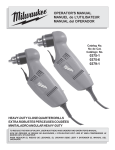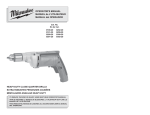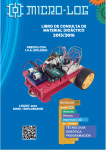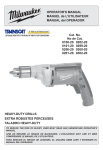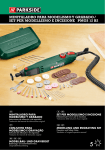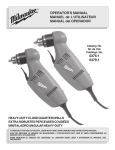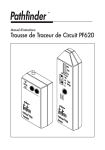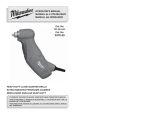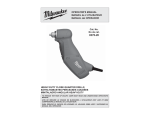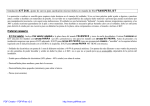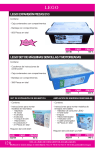Download Milwaukee 0202-20 Operator`s manual
Transcript
OPERATOR'S MANUAL MANUEL de L'UTILISATEUR MANUAL del OPERADOR Cat. No. No de Cat. 0100-20 0101-20 0200-20 0201-20 0202-20 0299-20 0300-20 0302-20 HEAVY-DUTY CLOSE QUARTER DRILLS EXTRA ROBUSTES PERCEUSES COUDÉES MINITALADRO ANGULAR HEAVY-DUTY TO REDUCE THE RISK OF INJURY, USER MUST READ OPERATOR'S MANUAL. AFIN DE RÉDUIRE LE RISQUE DE BLESSURES, L'UTILISATEUR DOIT LIRE LE MANUEL DE L'UTILISATEUR. PARA REDUCIR EL RIESGO DE LESIONES, EL USUARIO DEBE LEER EL MANUAL DEL OPERADOR. GENERAL SAFETY RULES — FOR ALL POWER TOOLS WARNING READ ALL INSTRUCTIONS Failure to follow all instructions listed below may result in electric shock, fire and/or serious injury. The term "power tool" in all of the warnings listed below refers to your mains-operated (corded) power tool or battery-operated (cordless) power tool. SAVE THESE INSTRUCTIONS PERSONAL SAFETY WORK AREA SAFETY 1. 2. 3. Keep work area clean and well lit. Cluttered or dark areas invite accidents. Do not operate power tools in explosive atmospheres, such as in the presence of flammable liquids, gases or dust. Power tools create sparks which may ignite the dust or fumes. Keep children and bystanders away while operating a power tool. Distractions can cause you to lose control. 9. 10. ELECTRICAL SAFETY 4. 5. 6. 7. 8. 2 11. Power tool plugs must match the outlet. Never modify the plug in any way. Do not use any adapter plugs with earthed (grounded) power tools. Unmodified plugs and matching outlets will reduce risk of electric shock. Avoid body contact with earthed or grounded surfaces such as pipes, radiators, ranges and refrigerators. There is an increased risk of electric shock if your body is earthed or grounded. Do not expose power tools to rain or wet conditions. Water entering a power tool will increase the risk of electric shock. Do not abuse the cord. Never use the cord for carrying, pulling or unplugging the power tool. Keep cord away from heat, oil, sharp edges or moving parts. Damaged or entangled cords increase the risk of electric shock. When operating a power tool outdoors, use an extension cord suitable for outdoor use. Use of a cord suitable for outdoor use reduces the risk of electric shock. 12. 13. 14. 15. 3 Stay alert, watch what you are doing and use common sense when operating a power tool. Do not use a power tool while you are tired or under the influence of drugs, alcohol or medication. A moment of inattention while operating power tools may result in serious personal injury. Use safety equipment. Always wear eye protection. Safety equipment such as dust mask, non-skid safety shoes, hard hat, or hearing protection used for appropriate conditions will reduce personal injuries. Avoid accidental starting. Ensure the switch is in the off-position before plugging in. Carrying power tools with your finger on the switch or plugging in power tools that have the switch on invites accidents. Remove any adjusting key or wrench before turning the power tool on. A wrench or a key left attached to a rotating part of the power tool may result in personal injury. Do not overreach. Keep proper footing and balance at all times. This enables better control of the power tool in unexpected situations. Dress properly. Do not wear loose clothing or jewellery. Keep your hair, clothing and gloves away from moving parts. Loose clothes, jewellery or long hair can be caught in moving parts. If devices are provided for the connection of dust extraction and collection facilities, ensure these are connected and properly used. Use of these devices can reduce dust-related hazards. POWER TOOL USE AND CARE FUNCTIONAL DESCRIPTION SPECIFIC SAFETY RULES 16. Do not force the power tool. Use the correct power tool for your application. The correct power tool will do the job better and safer at the rate for which it was designed. 17. Do not use the power tool if the switch does not turn it on and off. Any power tool that cannot be controlled with the switch is dangerous and must be repaired. 18. Disconnect the plug from the power source and/or the battery pack from the power tool before making any adjustments, changing accessories, or storing power tools. Such preventive safety measures reduce the risk of starting the power tool accidentally. 19. Store idle power tools out of the reach of children and do not allow persons unfamiliar with the power tool or these instructions to operate the power tool. Power tools are dangerous in the hands of untrained users. 20. Maintain power tools. Check for misalignment or binding of moving parts, breakage of parts and any other condition that may affect the power tool's operation. If damaged, have the power tool repaired before use. Many accidents are caused by poorly maintained power tools. 21. Keep cutting tools sharp and clean. Properly maintained cutting tools with sharp cutting edges are less likely to bind and are easier to control. 22. Use the power tool, accessories and tool bits etc., in accordance with these instructions and in the manner intended for the particular type of power tool, taking into account the working conditions and the work to be performed. Use of the power tool for operations different from those intended could result in a hazardous situation. 1. Hold tools by insulated gripping surfaces when performing an operation where the cutting tool may contact hidden wiring or its own cord. Contact with a "live" wire will make exposed metal parts of the tool "live" and shock the operator. 2 3 2. Use auxiliary handles supplied with the tool. Loss of control can cause personal injury. 3. Wear ear protectors with impact drills. Exposure to noise can cause hearing loss. 4. Maintain labels and nameplates. These carry important information. If unreadable or missing, contact a MILWAUKEE service facility for a free replacement. 5. WARNING: Some dust created by power sanding, sawing, grinding, drilling, and other construction activities contains chemicals known to cause cancer, birth defects or other reproductive harm. Some examples of these chemicals are: 1. Chuck 2. Side handle* 3. Nameplate • lead from lead-based paint 4. Lock button • crystalline silica from bricks and cement and other masonry products, and 5. Trigger 6. Forward/Reverse switch arsenic and chromium from chemicallytreated lumber. * Cat. Nos. 0200-20, 0202-20, 0299-20, 0300-20, 0302-20 only • Your risk from these exposures varies, depending on how often you do this type of work. To reduce your exposure to these chemicals: work in a well ventilated area, and work with approved safety equipment, such as those dust masks that are specially designed to filter out microscopic particles. 4 1 6 5 Symbology Specifications Catalog Volts No Load No. AC Amps RPM Double Insulated Underwriters Laboratories, Inc., United States and Canada Volts Alternating Current SERVICE No Load Revolutions per Minute (RPM) 23. Have your power tool serviced by a qualified repair person using only identical replacement parts. This will ensure that the safety of the power tool is maintained. Amperes Mexican Approvals Marking 4 5 0100-20 0101-20 0200-20 0201-20 0202-20 0299-20 0300-20 0302-20 120 120 120 120 120 120 120 120 7 7 7 7 7 8 8 8 0 - 2500 0 - 4000 0 - 1200 0 - 2500 0 - 1200 0 - 850 0 - 850 0 - 850 GROUNDING WARNING EXTENSION CORDS The grounding prong in the plug is connected through the green wire inside the cord to the grounding system in the tool. The green wire in the cord must be the only wire connected to the tool's grounding system and must never be attached to an electrically “live” terminal. Improperly connecting the grounding wire can result in the risk of electric shock. Check with a qualified electrician if you are in doubt as to whether the outlet is properly grounded. Do not modify the plug provided with the tool. Never remove the grounding prong from the plug. Do not use the tool if the cord or plug is damaged. If damaged, have it repaired by a MILWAUKEE service facility before use. If the plug will not fit the outlet, have a proper outlet installed by a qualified electrician. Your tool must be plugged into an appropriate outlet, properly installed and grounded in accordance with all codes and ordinances. The plug and outlet should look like those in Figure A. Double Insulated Tools: Tools with Two Prong Plugs Tools marked “Double Insulated” do not require grounding. They have a special double insulation system which satisfies OSHA requirements and complies with the applicable standards of Underwriters Laboratories, Inc., the Canadian Standard Association and the National Electrical Code. Double Insulated tools may be used in either of the 120 volt outlets shown in Figures B and C. Grounded Tools: Tools with Three Prong Plugs Tools marked “Grounding Required” have a three wire cord and three prong grounding plug. The plug must be connected to a properly grounded outlet (See Figure A). If the tool should electrically malfunction or break down, grounding provides a low resistance path to carry electricity away from the user, reducing the risk of electric shock. Grounded tools require a three wire extension cord. Double insulated tools can use either a two or three wire extension cord. As the distance from the supply outlet increases, you must use a heavier gauge extension cord. Using extension cords with inadequately sized wire causes a serious drop in voltage, resulting in loss of power and possible tool damage. Refer to the table shown to determine the required minimum wire size. Guidelines for Using Extension Cords The smaller the gauge number of the wire, the greater the capacity of the cord. For example, a 14 gauge cord can carry a higher current than a 16 gauge cord. When using more than one extension cord to make up the total length, be sure each cord contains at least the minimum wire size required. If you are using one extension cord for more than one tool, add the nameplate amperes and use the sum to determine the required minimum wire size. • If you are using an extension cord outdoors, be sure it is marked with the suffix “W-A” (“W” in Canada) to indicate that it is acceptable for outdoor use. • Be sure your extension cord is properly wired and in good electrical condition. Always replace a damaged extension cord or have it repaired by a qualified person before using it. • Protect your extension cords from sharp objects, excessive heat and damp or wet areas. Recommended Minimum Wire Gauge for Extension Cords* Extension Cord Length Nameplate Amperes 25' 50' 75' 100' 150' 0 - 2.0 2.1 - 3.4 3.5 - 5.0 5.1 - 7.0 7.1 - 12.0 12.1 - 16.0 16.1 - 20.0 18 18 18 18 16 14 12 18 18 18 16 14 12 10 18 18 16 14 12 10 18 16 14 12 10 16 14 12 12 * Based on limiting the line voltage drop to five volts at 150% of the rated amperes. READ AND SAVE ALL INSTRUCTIONS FOR FUTURE USE. Fig. B Fig. A 6 Fig. C 7 TOOL ASSEMBLY WARNING CHUCK IDENTIFICATION Chuck Type WARNING To reduce the risk of injury, always unplug tool before attaching or removing accessories or making adjustments. Use only specifically recommended accessories. Others may be hazardous. Adjusting the Side Handle (Cat. No. 0200-20, 0202-20, 0299-20, 0300-20, 0302-20) Removing and Replacing Quik-Lok ® Cords (Cat. No. 0100-20, 0101-20, 020220, 0302-20) Fig. 2 MILWAUKEE's exclusive Quik-Lok® Cords provide instant field replacement or substitution. Side handle Fig. 1 Double sleeve Keyless 0201-20 Single sleeve Keyless 0202-20 0302-20 Installing and Removing Bits Gearcase When using screwdriver bits, insert the bit far enough for the chuck jaws to grip the bit shank. Tighten the chuck jaws by hand to align the bit. WARNING To reduce the risk of injury, always remove the chuck key from the chuck after each use. 1. 2. To remove the Quik-Lok® Cord, turn the cord nut 1/4 turn to the left and pull it out. Detents Locking keys ® To replace the Quik-Lok Cord, align the connector keyways and push the connector in as far as it will go. Turn the cord nut 1/4 turn to the right to lock. 1. 2. 3. Side handle ring Turn the side handle counterclockwise to loosen. Slide the side handle assembly forward over the chuck and rotate to the desired angle. Keyed Chuck 3. To close the chuck jaws, place the chuck key in each of the three holes in the chuck. Turn the chuck key clockwise (Fig. 3). Tighten securely. 4. To remove the bit, insert the chuck key into one of the holes in the chuck. Turn the chuck key counterclockwise. These tools are equipped with a chuck tightened using a key. Always unplug the tool before installing or removing bits. 1. Fig. 3 Slide the side handle back to the gearcase and position the locking keys into the detents. The locking keys help prevent the handle from slipping. WARNING To open the chuck jaws, place the chuck key in one (1) of the three (3) holes located on the chuck. Turn the key counterclockwise (Fig. 3). To reduce the risk of injury, do not grasp the bit while the chuck is rotating or while the bit is falling from the chuck. Loosen Double Sleeve Keyless Chuck Tighten These tools are equipped with a hand tightening keyless chuck. Always unplug the tool before installing or removing bits. NOTE: The side handle ring must clear the chuck. 4. 0100-20 0101-20 0200-20 0299-20 0300-20 Keyed To reduce the risk of injury, always use a side handle when using this tool. Always brace and hold securely. Drill Cat. No. 1. Turn the side handle clockwise to tighten. NOTE: Always use the side handle for best control. To open the chuck jaws, hold the collar and turn the sleeve counterclockwise (Fig. 4). Fig. 4 Be sure the bit shank and chuck jaws are clean. Dirt particles may prevent the bit from lining up properly. 2. 8 When using drill bits, insert the bit into the chuck. Center the bit in the chuck jaws and lift it about 1/16" off of the bottom. Tighten the chuck jaws by hand to align the bit. Tighten Loosen 9 Be sure the bit shank and chuck jaws are clean. Dirt particles may prevent the bit from lining up properly. 2. Be sure the bit shank and chuck jaws are clean. Dirt particles may prevent the bit from lining up properly. When using drill bits, insert the bit into the chuck. Center the bit in the chuck jaws and lift it about 1/16" off of the bottom. Tighten the chuck jaws by hand to align the bit (Fig. 5). 2. Fig. 5 Fig. 8 When using screwdriver bits, insert the bit far enough for the chuck jaws to grip the bit shank. Tighten the chuck jaws by hand to align the bit. 3. When using screwdriver bits, insert the bit far enough for the chuck jaws to grip the bit shank. Tighten the chuck jaws by hand to align the bit. To close the chuck jaws, hold the collar and turn the sleeve clockwise (Fig. 6). Tighten securely. Fig. 6 When using drill bits, insert the bit into the chuck. Center the bit in the chuck jaws and lift it about 1/16" off of the bottom. Tighten the chuck jaws by hand to align the bit (Fig. 8). 3. Collar To close To close the chuck jaws, turn the chuck sleeve clockwise (Fig. 9). Tighten securely. Several detents will be felt as the chuck sleeve is turned. Fig. 9 To close To reduce the risk of injury, wear safety goggles or glasses with side shields. Unplug the tool before changing accessories or making adjustments. Chuck Removal This tool is equipped with a threaded spindle to hold the chuck. Before removing the chuck, unplug the tool and open the chuck jaws. A left-handed thread screw is located inside the chuck to prevent the chuck from loosening when the tool is operated in reverse direction. Remove the screw by turning it clockwise. To remove the chuck, hold the tool so that only the side of the chuck rests firmly and squarely on a solid workbench. Insert the chuck key or a chuck remover bar in one of the keyholes. Turn the chuck so the key is at about a 30° angle to the bench top and strike the key sharply with a hammer so the chuck turns in a counterclockwise direction (looking from the front of the tool). This should loosen the chuck from the spindle which has a right hand thread making it easy to remove the chuck by hand. Using Forward/Reverse Switch Fig. 11 Reverse NOTE: When replacing the chuck, always replace the left hand thread screw in the chuck. 1. For forward (clockwise) rotation, push the forward/reverse switch to the left position as shown. 2. For reverse (counterclockwise) rotation, push the forward/reverse switch to the right position as shown. Although an interlock prevents reversing the tool while the motor is running, allow it to come to a full stop before reversing. To reduce the risk of injury, keep hands and cord away from the bit and all moving parts. Starting, Stopping and Controlling Speed 1. To start the tool, pull the trigger. 2. To stop the tool, release the trigger. 3. To vary the drilling speed, simply increase or decrease pressure on the trigger. The further the trigger is pulled, the greater the speed. The spindle will remain locked until the tool is turned on. The spindle-lock mechanism will automatically disengage when the tool is turned on. To open the chuck jaws, turn the chuck sleeve counterclockwise (Fig. 7). 4. Fig. 7 Trigger WARNING NOTE: If the spindle rotates when opening or closing the chuck jaws, grasp the chuck and slightly rotate back and forth to engage the spindle-lock mechanism. Single Sleeve Keyless Chuck Forward Switch Sleeve To remove the bit, hold the chuck collar and turn the sleeve counterclockwise to release the bit from the chuck jaws. These tools are equipped with a spindle-lock mechanism and a single-sleeve keyless chuck. Always unplug the tool before inserting or removing bits. 1. WARNING To reduce the risk of injury, always wear eye protection. Fig. 10 Sleeve 4. OPERATION WARNING To remove the bit, turn the chuck sleeve counterclockwise to release the bit from the chuck jaws. Locking Trigger The lock button holds the trigger in the ON position for continuous full speed use. 1. To lock the trigger, hold the lock button in while pulling the trigger. Release the trigger. 2. To unlock the trigger, pull the trigger and release. The lock button will pop out. Tighten Loosen 10 11 Driving Screws APPLICATIONS Wood/Steel Steel Wood Cat. No. No Load Flat Boring Auger Hole Bits Bits Saws RPM Self-feed PathfinderTM Bits Bits NR 0100-20 0 - 2500 1-1/2" NR NR 0101-20 0 - 4000 1-1/4" NR NR 0200-20 0 - 1200 1-1/2" 1" 3-1/4" 0201-20 0 - 2500 1-1/2" 7/8" 2-1/4" NR 0202-20 0 - 1200 1-1/2" 1" 3-1/4" 0299-20 0 - 850 1-1/2" 1-1/2" 3-5/8" 0300-20 0 - 850 1-1/2" 1-1/2" 3-5/8" 0302-20 0 - 850 1-1/2" 1-1/2" 3-5/8" Twist Bits Hole Saws NR NR NR 1/4" NR NR 1/4" NR NR 1-1/4" 1/2" 1-5/8" 1-1/4" 1/2" NR 2-9/16" 1-1/4" 1/2" 1-5/8" 2-9/16" 1-1/4" 3/4" 2" 2-9/16" 1-1/4" 3/4" 2" 1-1/4" 3/4" 2" NR = Not recommended WARNING When drilling in wood, composition materials and plastic, start the drill slowly, gradually increasing speed as you drill. When using twist drill bits, pull the bit out of the hole frequently to clear chips from the bit flutes. Use low speeds for plastics with a low melting point. Selecting Bits When selecting a bit, use the right type for your job. For best performance, always use sharp bits. Drilling in Masonry When drilling in masonry, use high speed carbide-tipped bits. Drilling soft masonry materials such as cinder block requires little pressure. Hard materials like concrete require more pressure. A smooth, even flow of dust indicates the proper drilling rate. Do not let the bit spin in the hole without cutting. Do not use water to settle dust or to cool bit. Both actions will damage the carbide. Drilling 1. Before drilling, be sure the workpiece is clamped securely. Use backing material to prevent damage to the workpiece during breakthrough. 2. When starting a hole, place the drill bit on the work surface and apply firm pressure. Begin drilling at a slow speed, gradually increasing the speed as you drill. 3. Always apply pressure in line with the bit. Use enough pressure to keep the drill biting, but do not push hard enough to stall the motor. 4. Reduce pressure and ease the bit through the last part of the hole. While the tool is still running, pull the bit out of the hole to prevent jamming. Drilling in Metal When drilling in metal, use high speed steel twist drills or hole saws. Use slow speeds for hard metals and high speeds for softer metals. Lubricate drill bits with cutting oil when drilling in iron or steel. Use a coolant when drilling in nonferrous metals such as copper, brass or aluminum. Back the material to prevent binding and distortion on breakthrough. 12 Fig. 12 Forward rotation Stalling Reaction If the tool seems as if it is about to stall, maintain a firm grip and reduce pressure slightly to allow the bit to regain speed. If the tool does stall, release the trigger immediately. Reverse the motor, remove the bit from the work and start again. Do not pull the trigger on and off in an attempt to start a stalled drill. This can damage the drill. Bracing against the floor Fig. 13 Forward rotation Drilling in Wood, Composition Materials and Plastic To reduce the risk of explosion, electric shock and property damage, always check the work area for hidden pipes and wires before drilling. Typical Bracing Methods When driving screws, use the proper screwdriver bit for your job. After drilling pilot and shank holes, start the screw slowly and increase the speed as driving progresses. Set the screw by slowing to a stop. Do not run screws down at excessive speeds. To remove screws, reverse the motor. WARNING Reaction High rotational force. To reduce the risk of injury, always hold or brace securely. Always use side handle on tools rated 1200 rpm or less. Bracing against your leg Fig. 14 Reaction Bit Binding A high rotational force occurs when a bit binds. If the bit binds, the tool will be forced in the opposite direction of the bit rotation (See Fig. 12-14). Bits may bind if they are misaligned or when they are breaking through a hole. Wood boring bits can also bind if they run into nails or knots. Be prepared for bit binding situations. Reverse rotation To reduce the chance of bit binding: • Use sharp bits. Sharp bits are less likely to bind when drilling. • Use the proper bit for the job. There are bits that are designed for specific purposes. • Use caution when drilling pitchy, knotty, wet or warped material or when drilling in material that may contain nails. Forward rotation Bracing against a stud 13 MAINTENANCE FIVE YEAR TOOL LIMITED WARRANTY WARNING WARNING To reduce the risk of injury, always unplug your tool before performing any maintenance. Never disassemble the tool or try to do any rewiring on the tool's electrical system. Contact a MILWAUKEE service facility for ALL repairs. To reduce the risk of injury, electric shock and damage to the tool, never immerse your tool in liquid or allow a liquid to flow inside the tool. Cleaning Clean dust and debris from vents. Keep the tool handles clean, dry and free of oil or grease. Use only mild soap and a damp cloth to clean your tool since certain cleaning agents and solvents are harmful to plastics and other insulated parts. Some of these include: gasoline, turpentine, lacquer thinner, paint thinner, chlorinated cleaning solvents, ammonia and household detergents containing ammonia. Never use flammable or combustible solvents around tools. Maintaining Tools Keep your tool in good repair by adopting a regular maintenance program. Before use, examine the general condition of your tool. Inspect guards, switches, tool cord set and extension cord for damage. Check for loose screws, misalignment, binding of moving parts, improper mounting, broken parts and any other condition that may affect its safe operation. If abnormal noise or vibration occurs, turn the tool off immediately and have the problem corrected before further use. Do not use a damaged tool. Tag damaged tools “DO NOT USE” until repaired (see “Repairs”). Repairs If your tool is damaged, return the entire tool to the nearest service center. Under normal conditions, relubrication is not necessary until the motor brushes need to be replaced. After six months to one year, depending on use, return your tool to the nearest MILWAUKEE service facility for the following: • Lubrication • Brush inspection and replacement • Mechanical inspection and cleaning (gears, spindles, bearings, housing, etc.) • Electrical inspection (switch, cord, armature, etc.) • Testing to assure proper mechanical and electrical operation Every MILWAUKEE electric power tool (including battery charger) is warranted to the original purchaser only to be free from defects in material and workmanship. Subject to certain exceptions, MILWAUKEE will repair or replace any part on a electric power tool which, after examination, is determined by MILWAUKEE to be defective in material or workmanship for a period of five (5) years* after the date of purchase. Return the electric power tool and a copy of proof of purchase to a MILWAUKEE factory Service/Sales Support Branch location or MILWAUKEE Authorized Service Station, freight prepaid and insured, are requested for this warranty to be effective. This warranty does not apply to damage that MILWAUKEE determines to be from repairs made or attempted by anyone other than MILWAUKEE authorized personnel, misuse, alterations, abuse, normal wear and tear, lack of maintenance, or accidents. * The warranty period for Hoists (lever, hand chain, & electric chain hoists), all Ni-CD battery packs, Work Lights (cordless flashlights), Job Site Radios, and Trade Titan™ Industrial Work Carts is one (1) year from the date of purchase. *The warranty period for Li-Ion battery packs that do not contain V™-technology – 4.0 volts through 18.0 volts - is two (2) years from the date of purchase. *There is a separate warranty for V™-technology Li-Ion Battery Packs V™18 volts and above that accompany V™-technology cordless power tools: *Every MILWAUKEE V™-technology Li-Ion Battery Pack 18 volts or above is covered by an initial 1000 Charges/2 Years free replacement warranty. This means that for the earlier of the first 1000 charges or two (2) years from the date of purchase/first charge, a replacement battery will be provided to the customer for any defective battery free of charge. Thereafter, customers will also receive an additional warranty on a pro rata basis up to the earlier of the first 2000 charges or five (5) Years from the date of purchase/first charge. This means that every customer gets an additional 1000 charges or three (3) years of pro rata warranty on the V™-technology Li-Ion Battery Pack 18 volts or above depending upon the amount of use. During this additional warranty period, the customer pays for only the useable service received over and above the first 1000 Charges/2 years, based on the date of first charge and number of charges found on the battery pack via Milwaukee’s V™-technology Service Reader. Warranty Registration is not necessary to obtain the applicable warranty on a MILWAUKEE product. However, proof of purchase in the form of a sales receipt or other information deemed sufficient by MILWAUKEE, is requested. ACCESSORIES WARNING To reduce the risk of injury, always unplug the tool before attaching or removing accessories. Use only specifically recommended accessories. Others may be hazardous. ACCEPTANCE OF THE EXCLUSIVE REPAIR AND REPLACEMENT REMEDIES DESCRIBED HEREIN IS A CONDITION OF THE CONTRACT FOR THE PURCHASE OF EVERY MILWAUKEE PRODUCT. IF YOU DO NOT AGREE TO THIS CONDITION, YOU SHOULD NOT PURCHASE THE PRODUCT. IN NO EVENT SHALL MILWAUKEE BE LIABLE FOR ANY INCIDENTAL, SPECIAL, CONSEQUENTIAL OR PUNITIVE DAMAGES, OR FOR ANY COSTS, ATTORNEY FEES, EXPENSES, LOSSES OR DELAYS ALLEGED TO BE AS A CONSEQUENCE OF ANY DAMAGE TO, FAILURE OF, OR DEFECT IN ANY PRODUCT INCLUDING, BUT NOT LIMITED TO, ANY CLAIMS FOR LOSS OF PROFITS. THIS WARRANTY IS EXCLUSIVE AND IN LIEU OF ALL OTHER WARRANTIES OR CONDITIONS, WRITTEN OR ORAL, EXPRESSED OR IMPLIED. WITHOUT LIMITING THE GENERALITY OF THE FOREGOING, MILWAUKEE DISCLAIMS ANY IMPLIED WARRANTY OF MERCHANTABILITY OR FITNESS FOR A PARTICULAR USE OR PURPOSE, AND ALL OTHER WARRANTIES. This warranty applies to product sold in the U.S.A., Canada and Mexico only. For a complete listing of accessories refer to your MILWAUKEE Electric Tool catalog or go on-line to www.milwaukeetool.com. To obtain a catalog, contact your local distributor or a service center. Quik-Lok™ Cord Sets 8' - Cat. No. 48-76-4008 25' - Cat. No. 48-76-4025 14 15








